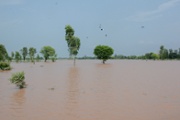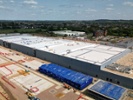|
|
 
| Technology and the Water Industry |
|
The water industry has been developing innovative and advanced technology and AI to reduce water and waste in various applications including data centers, water and wastewater facilities and municipalities. Although researchers around the world are hard at work on solutions to address water-use issues surrounding data centers and AI, there is still a lot of ground that needs to be covered.
This Special Report, sponsored by Ecolab, takes a deeper look at the issues surrounding data centers, AI and advanced technology in the water industry.
|
|
|
Keep your data centers running at peak performance with cooling systems that support uptime and reduce resource use, cutting costs and reducing environmental impact. Ecolab brings the proven expertise and innovation to make it happen. Discover More |
|
|
| ADVERTISEMENT |  |
|
 
|
Water is becoming a crucial economic variable as climate change and artificial intelligence drive demand. Companies are increasingly using advanced tools such as the Water Footprint Assessment tool to measure their water usage more accurately, revealing the full extent of their dependence on water. Financial markets are beginning to reflect water-related risks, with adaptation bonds and other financial instruments emerging to support water resilience projects.
|
|
|
The rapid growth of data centers is significantly increasing demand for electricity and water, yet utilities often overlook the sector's impact on supplies in planning, creating challenges for infrastructure resilience, write Pete Elliott and Richard Tribble of ChemTreat. They explore why water systems, power producers and data center operators need to collaborate on integrated resource planning to balance water and energy use while ensuring sustainable operations amid rising demand.
|
|
|
Many leading tech companies do not fully disclose the amount of water their data centers consume, and available data often lacks consistency and detail, write Peyton McCauley and Melissa Scanlan of the University of Wisconsin-Milwaukee. The Lawrence Berkeley National Laboratory estimates that data centers in the US consumed 17 billion gallons of water directly for cooling in 2023, a figure that could quadruple by 2028. In this piece, McCauley and Scanlan discuss the lack of transparency in data center water use and how to correct it.
|
|
| |
 |
| Submerged farmland in Pakistan. (Raja Imran/Getty Images) |
AI-driven weather forecasting models are revolutionizing agriculture by providing accurate, localized predictions at a fraction of the cost of traditional methods. This technology is particularly beneficial for farmers in low- and middle-income countries, who face increasing risks from climate change. Models such as Pangu-Weather and GraphCast have demonstrated their effectiveness, but the challenge lies in implementing these tools where they are most needed.
|
|
|
The US food, agriculture and water industries are among the most underprotected critical infrastructure sectors, facing significant threats from adversaries, the FBI has warned. A proposed biosurveillance intelligence, surveillance and reconnaissance system could enhance security by integrating AI and sensors to monitor the supply chain from production to consumption, ensuring timely and accurate threat detection.
|
|
|
|
|
Keep your data centers running at peak performance with cooling systems that support uptime and reduce water usage and energy use, lowering environmental impact. Ecolab brings the proven expertise and innovation to make it happen. Discover More |
|
|
|
| ADVERTISEMENT |  |
|
 
|
Ecolab's latest Watermark Study reveals that as artificial intelligence workloads accelerate, data centers' demand for water is surging -- yet most consumers underestimate the scale of this water use. Only 41% of US consumers are aware that AI systems require significant water, even though water-cooled infrastructure now dominates data center operations.
|
|
| |
 |
| (Richard Newstead/Getty Images) |
AI systems consume significant amounts of water, with estimates showing that a short conversation with OpenAI's GPT-3 can use up to 500 milliliters, primarily for cooling data centers and powering servers. Water usage varies based on location, climate and the AI model used, with newer technologies like immersion cooling and Microsoft's zero-water cooling system offering potential reductions. This piece includes a simple three-step process to help individuals estimate their AI water footprint.
|
|
|
Data centers in England use less water than previously thought, with nearly two-thirds consuming less than 10,000 cubic meters annually, a survey by techUK and the Environment Agency recently found. The report attributes this to the widespread adoption of waterless and closed-loop cooling systems, with more than half of data centers already using these technologies.
|
|
|
The rise of AI is increasing heat generation in data centers, necessitating more effective and water-conserving cooling solutions, write Veolia executives Ann Feng and David Kirkland. Some operators are turning to treated wastewater, rainwater collection and surface water from sources such as canals or lakes to help keep their centers cool.
|
|
|
|
Ecolab CEO Christophe Beck said at a climate conference that climate action must be performance-led, and the company he leads is proving it through water stewardship that integrates AI with energy and supply chain management. Beck's strategy has reduced Ecolab's water impact intensity by 29% and aims for a 40% reduction by 2030. The company has helped customers save 226 billion gallons of water, nearing its 2025 goal of 234 billion gallons.
|
|
|
XGS Energy has completed a field test of its closed-loop geothermal system in California's Mojave Desert, paving the way for a 150-megawatt project that will support Meta's data centers in New Mexico. The technology presents a pathway to scale geothermal for data centers in water-sensitive regions because it eliminates water loss concerns associated with traditional geothermal solutions.
|
|
|
Veolia's new Hubgrade command center in Scottsdale, Ariz., represents a leap in water management, using tools such as virtual reality, drones and AI-driven robotics to oversee systems around the country. The innovations allow for more efficient operations, cost savings and improved water quality, offering municipalities the ability to modernize and enhance their infrastructure.
|
|
| | | |
